A list of facts can be scary. As you consider the information here, remember that with on-time screening and timely evaluation of symptoms, colon cancer is preventable, treatable and beatable!
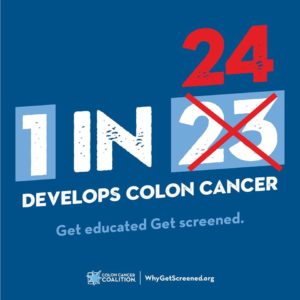

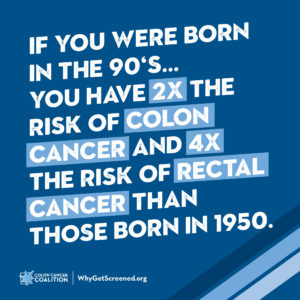
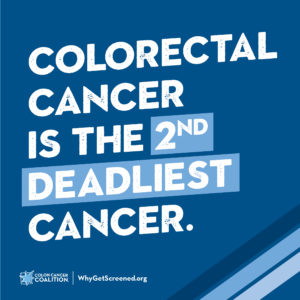
About Colorectal Cancer
 Colon cancer is cancer of the colon. Rectal cancer is cancer in the rectum. Together they are colorectal.
Colon cancer is cancer of the colon. Rectal cancer is cancer in the rectum. Together they are colorectal.- It is the fourth most commonly diagnosed cancer and the second leading cause of cancer death.
- Colorectal cancer affects men and women, and people of all races and nationalities.
- 30% of CRC diagnoses are under the age of 55.
- The 5-year relative survival rate for stage 1 and stage II colon cancer is 90%; the 5-year survival rate for patients diagnosed at stage III is 71% and stage IV is 14%.
- Often, those who are diagnosed with colorectal cancer have experienced no signs or symptoms associated with the disease.
Family History
- People with a parent, sibling, or offspring with colorectal cancer have 2 or 3 times the risk of developing colon cancer compared to those with no family history of the disease.
- While most people diagnosed with colon cancer have no family history of the disease, those with a family history should begin screening at an earlier age.
- When a relative is diagnosed at a young age or if there is more than one affected relative, the risk of developing colorectal cancer increases to three to six times that of the general population.
- Up to one-third of people diagnosed before 50 have a family history or genetic predisposition.
- 5% of patients have an inherited genetic condition such as Lynch syndrome (Hereditary Non-Polyposis Colon Cancer or HNPCC), Familial Adenomatous Polyposis (FAP), or MYH Associated Polyposis (MAP).
Colorectal Cancer in Young People
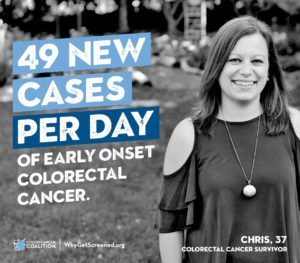
- CRC is now the leading cause of cancer death in men and the second in women under 50 years old.
- 30% of CRC diagnoses are under age 55.
- While rates of colorectal cancer have been declining among adults 50 years and older, incidence of colorectal cancer is increasing among adults under age 50.
- People born after 1990 have 2 times the risk of developing colon cancer and 4 times the risk of developing rectal cancer than those born in 1950.
- Annually, there will be about 18,000 cases of colorectal cancer diagnosed in people under 50, the equivalent of 49 new cases per day.
- An estimated 49 new cases of colorectal cancer in people under 50 are diagnosed a day, or 18,000 each year.
- Younger adults were more likely than older adults to be diagnosed with late-stage colon or rectal cancers because they are under the recommended screening age.
- Two-thirds of young adults diagnosed with colorectal cancer experience symptoms for months before they’re finally diagnosed.
- Misdiagnosis in adults under 50 often leads to later stage diagnosis and treatment.
What About Screening?
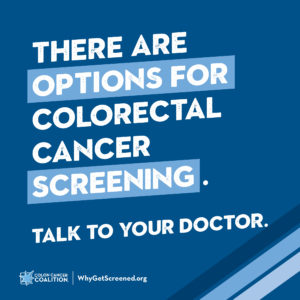
- Screening should begin at age 45 for average risk adults with no family history.
- Colorectal polyps are common in American adults. Anywhere between 15 and 40% of adults may have colon polyps. Approximately 3.4% of polyps are precancerous.
- Screening for colorectal cancer through a colonoscopy can prevent cancer by removing pre-cancerous polyps.
- There are many screening tests available, including some non-invasive, inexpensive tests that can be done in the privacy of your own home.
- Being screened at the recommended frequency increases the likelihood that when colorectal cancer is present, it will be detected at an earlier stage.
- When colorectal cancer is detected in its early stages it is more likely to be cured, treatment is less extensive, and the recovery is much faster.
- The risk of developing or dying from colorectal cancer can be reduced by maintaining a healthy body weight, regular physical activity, limiting intake of red and processed meats, and by not smoking.
- Colorectal cancer doesn’t always cause symptoms, and symptoms may not appear until the cancer is more advanced, so on-time screening is critical.
What else?
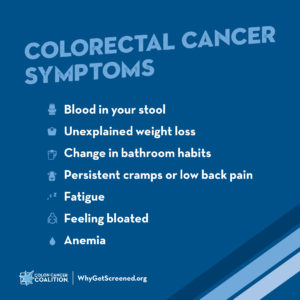
- Colorectal cancer screening rates have slowly increased, but rates still remain low, especially among those who are uninsured.
- Colorectal cancer incidence rates in individuals of screening age have been declining in the US since the mid-1980s, due to increased awareness and screening.
- Colorectal cancer usually develops slowly over a period of 10 to 15 years.
- Colorectal cancer rates in the US vary widely by geographic area. Contributing factors include regional variations in risk factors and access to screening and treatment.
- Racial/ethnic groups have a higher mortality rate from colorectal cancer because they are less likely to be screened on-time, have less access to screening, and less likely to have colorectal cancer detected at its earliest stages.
- 51% of those ages 50-54 are not up to date on their colorectal cancer screening.
- Total treatment cost for colorectal cancers in the United States is about $14 billion per year.
- With on-time screening and testing, colorectal cancer is Preventable, Treatable and Beatable.
References
American Cancer Society: 2024 Cancer Facts and Figures
American Cancer Society: Key Statistics for Colorectal Cancer
American Cancer Society Press Release: Colorectal Cancer Burden Shifting to Younger Individuals
American Cancer Society: Survival Rates for Colorectal Cancer
National Institutes of Health: Cancer Cost Projections
Next >> What are the Symptoms?
Information on these pages is provided for informational purposes only. Consult your own physician before making any medical decisions.
